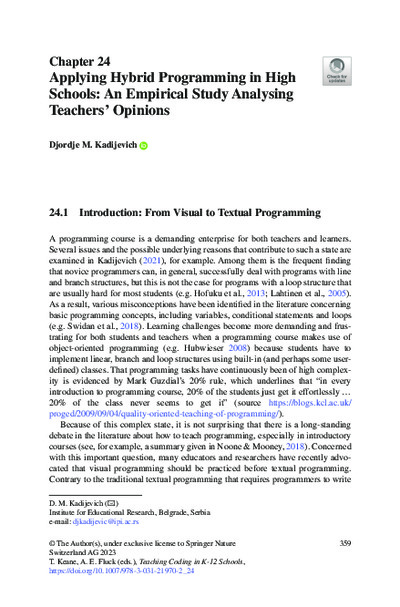Applying Hybrid Programming in High SchoolsAn Empirical Study Analysing Teachers’ Opinions
Djordje M. Kadijevich
Publikationsdatum:
|
 |
 Diese Seite wurde seit 2 Jahren inhaltlich nicht mehr aktualisiert.
Unter Umständen ist sie nicht mehr aktuell.
Diese Seite wurde seit 2 Jahren inhaltlich nicht mehr aktualisiert.
Unter Umständen ist sie nicht mehr aktuell.
 Zusammenfassungen
Zusammenfassungen
 The transition from visual programming to textual programming reveals a considerable increase in the overall complexity of programming, including a number of challenging issues. To support this transition and alleviate some of these challenges, so-called hybrid programming may be applied. This programming usually refers to the use of a single programming language in block- and text-based modalities within one computing environment. Research shows that the application of hybrid programming for a certain age group may positively contribute to the development of students’ programming knowledge and skills as they proceed towards the exclusive use of text-based programming. However, teachers of programming may not be willing to do this, because of limited teaching hours, a demanding syllabus, lack of resources or for other reasons. By using a sample of 38 high school teachers of programming, this study examined teachers’ opinions about applying hybrid programming in their teaching and analysed their preference for hybrid programming usage in terms of a number of background variables, such as type of school, teacher’s experience and programming language used. The examination of these teachers’ opinions revealed that although visual programming may be used as a scaffolding support for textual programming, the opponents of hybrid programming usage did not (realize and) acknowledge this aspect of visual programming. On the other hand, the proponents of hybrid programming usage did mention several affordances related to this aspect, but they had rarely examined them in terms of the particular challenges of the transition in question. The analysis showed that hybrid programming usage was influenced by hybrid programming experience, the text-based programming languages applied and the country region. Suggestions for practice and research are included.
The transition from visual programming to textual programming reveals a considerable increase in the overall complexity of programming, including a number of challenging issues. To support this transition and alleviate some of these challenges, so-called hybrid programming may be applied. This programming usually refers to the use of a single programming language in block- and text-based modalities within one computing environment. Research shows that the application of hybrid programming for a certain age group may positively contribute to the development of students’ programming knowledge and skills as they proceed towards the exclusive use of text-based programming. However, teachers of programming may not be willing to do this, because of limited teaching hours, a demanding syllabus, lack of resources or for other reasons. By using a sample of 38 high school teachers of programming, this study examined teachers’ opinions about applying hybrid programming in their teaching and analysed their preference for hybrid programming usage in terms of a number of background variables, such as type of school, teacher’s experience and programming language used. The examination of these teachers’ opinions revealed that although visual programming may be used as a scaffolding support for textual programming, the opponents of hybrid programming usage did not (realize and) acknowledge this aspect of visual programming. On the other hand, the proponents of hybrid programming usage did mention several affordances related to this aspect, but they had rarely examined them in terms of the particular challenges of the transition in question. The analysis showed that hybrid programming usage was influenced by hybrid programming experience, the text-based programming languages applied and the country region. Suggestions for practice and research are included. Dieser wissenschaftliche Zeitschriftenartikel erwähnt ...
Dieser wissenschaftliche Zeitschriftenartikel erwähnt ...
 Personen KB IB clear | Amjad AlTadmri , Neil C. C. Brown , Stephen C. F. Chan , Joey C. Y. Cheung , Felienne Hermans , Djordje M. Kadijevich , Michael Kölling , Winnie W. Y. Lau , Grace Ngai , Marileen Smit , Peer Stechert , Alaaeddin Swidan , Goran Vukovic | ||||||||||||||||||||||||||||||||||||||||||||||||||||||
 Begriffe KB IB clear | Fehlvorstellungen / misconceptions
, Fehlvorstellungen beim Programmieren
, Fehlvorstellungen bezüglich Schleifen
,  Programmieren Programmieren programming
, Programmiersprachenprogramming languages programming
, Programmiersprachenprogramming languages
| ||||||||||||||||||||||||||||||||||||||||||||||||||||||
 Bücher |
| ||||||||||||||||||||||||||||||||||||||||||||||||||||||
 Texte |
|
 Dieser wissenschaftliche Zeitschriftenartikel erwähnt vermutlich nicht ...
Dieser wissenschaftliche Zeitschriftenartikel erwähnt vermutlich nicht ... 
 Nicht erwähnte Begriffe | blockbasierte Programmierumgebungen, Fehlvorstellungen bezüglich Variablen, Programmierkonzepte |
 Tagcloud
Tagcloud
 Zitationsgraph
Zitationsgraph
 Zitationsgraph (Beta-Test mit vis.js)
Zitationsgraph (Beta-Test mit vis.js)
 Zeitleiste
Zeitleiste
 Anderswo finden
Anderswo finden
 Volltext dieses Dokuments
Volltext dieses Dokuments
 |  Applying Hybrid Programming in High Schools: An Empirical Study Analysing Teachers’ Opinions: Artikel als Volltext @ Springer ( Applying Hybrid Programming in High Schools: An Empirical Study Analysing Teachers’ Opinions: Artikel als Volltext @ Springer ( : :  , 357 kByte; , 357 kByte;  : :  ) ) |
 Anderswo suchen
Anderswo suchen 
 Beat und dieser wissenschaftliche Zeitschriftenartikel
Beat und dieser wissenschaftliche Zeitschriftenartikel
Beat hat Dieser wissenschaftliche Zeitschriftenartikel während seiner Zeit am Institut für Medien und Schule (IMS) ins Biblionetz aufgenommen. Er hat Dieser wissenschaftliche Zeitschriftenartikel einmalig erfasst und bisher nicht mehr bearbeitet. Beat besitzt kein physisches, aber ein digitales Exemplar. Eine digitale Version ist auf dem Internet verfügbar (s.o.). Aufgrund der wenigen Einträge im Biblionetz scheint er es nicht wirklich gelesen zu haben. Es gibt bisher auch nur wenige Objekte im Biblionetz, die dieses Werk zitieren.














 Biblionetz-History
Biblionetz-History